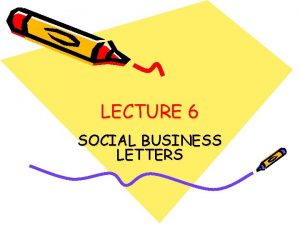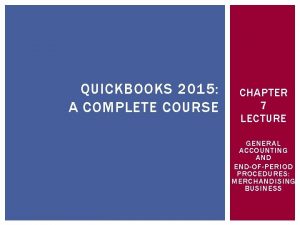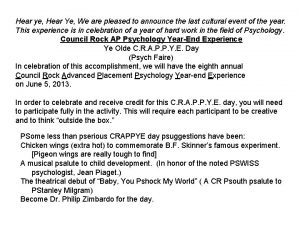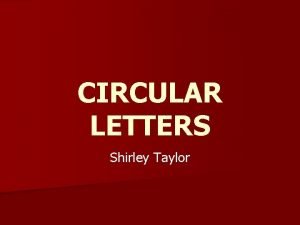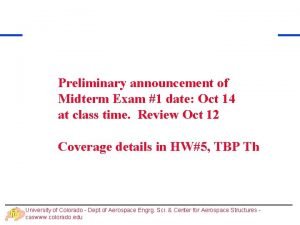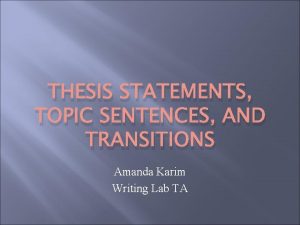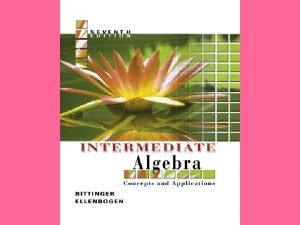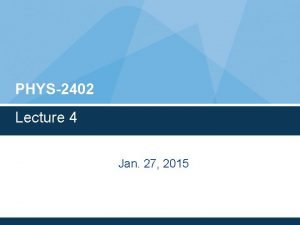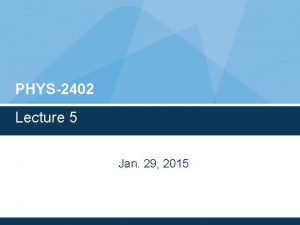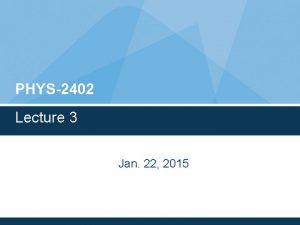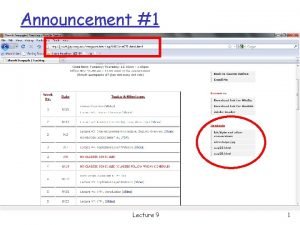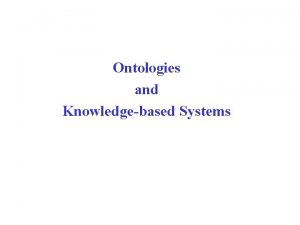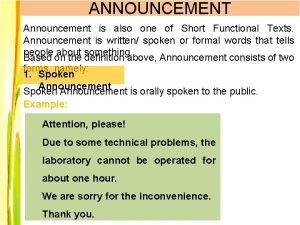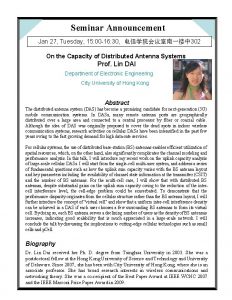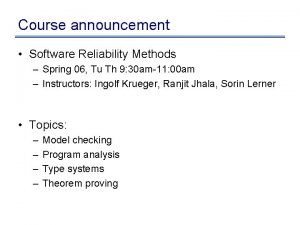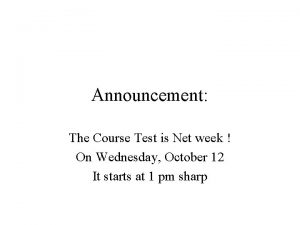PHYS2402 Lecture 2 Jan 20 2015 Announcement Course





































- Slides: 37

PHYS-2402 Lecture 2 Jan. 20, 2015

Announcement Course webpage http: //highenergy. phys. ttu. edu/~slee/2402/ Textbook Lecture Notes, HW Assignments, Physics Colloquium, etc. .


Quantum mechanics (1920’s-) Classical physics Newtonian Mechanics, Thermodynamics Statistical Mechanics Relativistic quantum mechanics (1927 -) Relativistic mechanics, El. -Mag. (1905) Maxwell’s Equations of electromagnetism (1873)

Quantum mechanics (1920’s-) Classical physics Relativistic quantum mechanics (1927 -) Relativistic mechanics, El. -Mag. (1905) Structure of the course “Modern Physics”

Quantum mechanics (1920’s-) Classical physics Relativistic quantum mechanics (1927 -) Relativistic mechanics, El. -Mag. (1905)

Quantum mechanics (1920’s-) Classical physics Relativistic quantum mechanics (1927 -) Relativistic mechanics, El. -Mag. (1905)

Quantum mechanics (1920’s-) Classical physics Relativistic quantum mechanics (1927 -) Relativistic mechanics, El. -Mag. (1905)

Modern Physics • Two basic ideas – Time and space are not absolutes. – Particles behave like waves and waves behave like particles. • Two branches – Special Relativity – Quantum Mechanics With an understanding of these branches, we can then explore areas of modern physics such as superconductivity, modern optics, nuclear physics, particle physics and cosmology - along with a host of other areas of science. 9

Chapter 2 Special Relativity 1. Basic Ideas 6. Velocity Transformation 2. Consequences of Einstein’s Postulates 7. Momentum & Energy 3. The Lorentz Transformation Equations 8. General Relativity & a 1 st Look at Cosmology 4. The Twin Paradox 9. The Light Barrier 5. The Doppler Effects 10. The 4 th Dimension

What is relativity? • The dependence of various physical phenomena on relative motion of the observer & the observed objects • Properties: – An observer in motion and an observer at rest may disagree on the sequence of events. – However, they do agree on the results. (example: ball thrown in air) – The laws that govern the motion are the same. – We can transform from one frame to another using a Galilean Transformation. 11

Galilean-Newtonian Relativity • Galilean-Newtonian relativity is known as a “classical” theory. • Einstein’s special theory of relativity is known as a “modern” theory. 12

Galilean Transformation y y´ K´ K O z z´ v Reference frame: A system of coordinates defined for an observer. Convention is to have the observer at the origin of the system & to define all distances relative to that point. Each reference frame can have it’s own origin. O´ x´ x ✴ Reference frame K’ is moving at constant velocity v w. r. t. to K. (Restrict motion to x-axis) 13

Galilean Transformation y y´ K´ K O v Inertial Reference frame (K’): A frame of reference in which an object experiencing zero net force moves at constant velocity. • i. e. F = 0, so a frame is not accelerating. • Galilean Transformation holds O´ x´ x x´ = x – vt z z´ y´ = y z´ = z Time is absolute t´ = t ? ? 14

Galilean Transformation y´ K´ y K v x´ vt x O EVENT x O´ ✴ Reference frame K’ is moving at constant velocity v w. r. t. to K. (Restrict motion to x-axis) ✴ Transform from K’ to K: x´ x´ = x – vt y´ = y z´ = z Time is absolute t´ = t 15

Galilean Transformation y´ K´ y K v x´ vt O ✴ Note: EVENT x x O´ we will use u’ and u to designate the velocity of the ball in respective coordinate systems x´ x´ = x – vt y´ = y z´ = z t´ = t 16

Galilean Transformation y´ K´ y K v x´ vt O EVENT x x O´ x´ Let’s check that the 2 nd Newton’s Law is invariant under Galilean Transformations: acceleration is the same in all IRFs differentiate again : 17

Galilean Transformation y y´ K´ K O z z´ v O´ x´ x What does it mean for a quantity or law to be INVARIANT? The quantity or law remains unchanged when after undergoing a transformation to a different coordinate system. Non-invariant Quantities x’ = x & v’ = v Invariant Quantities a’ = a, F’ = ma = F The Laws of Mechanics are unchanged under a Galilean transformation 18

Galilean Transformation y y´ K´ K O z In 1873, Maxwell formulated Equations of Electromagnetism. v On one hand, Maxwell’s Equations describe very well all observed e. -m. phenomena, on the other hand, they are not invariant under G. Tr. ! O´ x´ x z´ The Laws of E&M are changed under a Galilean transformation (unless v << c) 19

Galilean Transformation y y´ K´ K O Examine the E&M wave equation v Transform using x’ = x - vt, t’ = t and the chain rule for derivatives. O´ x´ x We obtain: z z´ The Laws of E&M are changed under a Galilean transformation (unless v << c) What are the options? At least one of the following statements must be wrong: (a) the principle of relativity applies to both mechanical and e. -m. phenomena; (b) Maxwell’s eqs are correct; (c) G. Tr. are correct. 20

Historical Perspective • Light is a wave. • Waves require a medium through which to propagate. Proposed solution: Light waves travel in a medium called ether (or aether: from Greek, meaning upper air). (Like sound waves in air or water waves in water) The ether becomes the absolute and unique frame of reference where Maxwell’s equations hold. Maxwell’s equations assume that light obeys the Newtonian-Galilean transformation. 21

Wave Propagation 22

The Michelson-Morley Experiment • • • Experiment designed to measure small changes in the speed of light was performed by Michelson (1852– 1931, Nobel ) and Morley (1838– 1923). Used an optical instrument called an interferometer that Michelson invented. Device was to detect the presence of the ether. Start two light beams at the same point & time, then send them on two paths • • • Parallel to Ether: one path parallel to the motion of the earth through the ether one perpendicular Measure the time difference it takes for them to arrive at the same point Perpendicular to Ether: 23

The Michelson-Morley Experiment Parallel to Ether: Perpendicular to Ether: Time for each trip is given by Problem: The speed of Earth moving through the ether is ~10, 000 times smaller than the speed of light. Instrumentation of the period was not sensitive enough to measure such small timing differences. Solution: Observe the interference between the two beams. 24

The Michelson-Morley Experiment If the two beams are moving at different speeds, there will be a fast arm and a slow arm. Deduce Δt from observed # fringes. T=period of light wave Observation: No fringe. Outcomes of Michelson-Morley Experiment • • The speed of light was shown to be independent of the motion of the observer. Helped cast away the ether hypothesis E&M explained the origin of light, but did not require a medium for its wave propagation 1907 Nobel Prize awarded to Michelson (1 st American Physicist) 25

Einstein’s Postulates Big problem at the turn of the century: 1. Michelson-Morley showed that the Galilean transformation did not hold for Maxwell’s equation. 2. Maxwell’s equations could not be wrong. 3. Galilean transformation did hold for the laws of mechanics. 4. Einstein proposed a solution 26

Einstein’s Principle of Relativity (1905) Einstein's Principle of Relativity (the first postulate of the Special Theory of Relativity): “The laws of physics are the same (covariant) in all inertial reference frames”. The second postulate: “The speed of light in vacuum is the same to all observers, regardless of their motion relative to the light source”. Thus, Maxwell’s Equations are in line with Einstein’s Principle of Relativity. Conclusion: Galilean Transformations must go. Einstein needed to find a new transformation (we will see this on Thursday) The idea of universal and absolute time is wrong! One has to come up with correct transformations that “work” for both mechanical and E&M phenomena (any speed up to ~c). Consequently, the laws of mechanics have to be modified to be covariant under new (correct) transformations.

Observers in all inertial systems measure the same value for the speed of light in a vacuum. (c = 2. 9979 x 108 m/s)

The Ultimate Speed • The speed of light has been defined to be exactly: c = 299 792 458 m/s • Light travels at this ultimate speed, as do any massless particles. • No entity that carries energy or information can exceed this speed limit. • No particle that does have a mass, can actually reach c. • Electrons have been accelerated to at least 0. 999 999 95 times the speed of light—still less than c. 29


Principle of Simultaneity Two events that are simultaneous in one reference frame (K) are not necessarily simultaneous in another reference frame (K´) moving with respect to the first frame.





“The speed of light in vacuum is the same for all inertial observers, regardless of the motion of the source”.

This is not an optical illusion. Space and time are different for all observers in relative motion.
 Social business letter
Social business letter 01:640:244 lecture notes - lecture 15: plat, idah, farad
01:640:244 lecture notes - lecture 15: plat, idah, farad Attachude
Attachude Deforestation public service announcement
Deforestation public service announcement Mmai illinois
Mmai illinois Bert van bruchem
Bert van bruchem Nvr announcement example
Nvr announcement example Dan hughes shield of shame
Dan hughes shield of shame Hear ye definition
Hear ye definition Pvu announcement today
Pvu announcement today How to write a circular letter
How to write a circular letter Midterm exam announcement
Midterm exam announcement Willard scott birthday announcement form
Willard scott birthday announcement form Presidential elections exploration and announcement
Presidential elections exploration and announcement Short functional text advertisement
Short functional text advertisement What is the subject of the announcement
What is the subject of the announcement Define ideological parties
Define ideological parties Topic sentence and thesis statement
Topic sentence and thesis statement Announcement there will be a holiday camp next month
Announcement there will be a holiday camp next month Cell phone energy transformation
Cell phone energy transformation Contoh announcement tentang study tour
Contoh announcement tentang study tour Please turn off your cell phone announcement
Please turn off your cell phone announcement Building with bricks
Building with bricks Course title and course number
Course title and course number Course interne moyenne externe
Course interne moyenne externe Gred spm 2015
Gred spm 2015 World economic forum 2015
World economic forum 2015 Sino ang di sakop ng republic act 10666
Sino ang di sakop ng republic act 10666 Ebikeshop
Ebikeshop Controle de informação documentada iso 9001
Controle de informação documentada iso 9001 Permendikbud no 23 tahun 2015
Permendikbud no 23 tahun 2015 How do you know if a table is proportional
How do you know if a table is proportional January 29 2015
January 29 2015 Legge n. 107 del 2015
Legge n. 107 del 2015 Rd n° 160-2015/digesa/sa
Rd n° 160-2015/digesa/sa Do. 27 s. 2015 promoting family earthquake preparedness
Do. 27 s. 2015 promoting family earthquake preparedness Pearson education inc publishing
Pearson education inc publishing Angst+pfister iso 14001:2015
Angst+pfister iso 14001:2015
